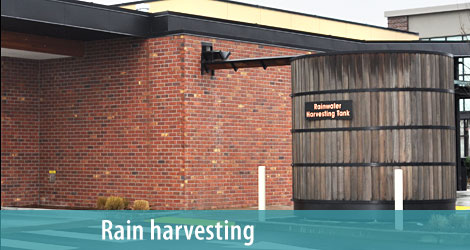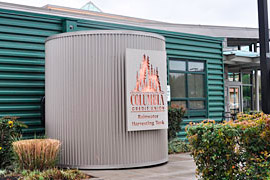Rainwater Harvesting
Rainwater harvesting systems collect and store rainfall for later use. When designed appropriately, rainwater harvesting systems slow and reduce runoff and provide a source of water. Cisterns are constructed of durable material, such as concrete, plastic, polyethylene, or metal. They are larger and usually more permanent than rain barrels, ranging in size from 100 gallons to 10,000 gallons. They can be placed above ground, underground or on a rooftop. A roof filter is typically utilized to remove contaminants and debris before the runoff enters the cistern. A pipe from the cistern conveys the stored water, either by gravity or pump, to the designated interior or exterior use. In some instances, an overflow system conveys excess runoff to a destination location. Water is typically used for irrigation, saving long-term costs.
FEATURED SITE - Columbia Credit Union at Grand Central
108 Grand Blvd., Vancouver
The credit union, built in 2008 as part of the Grand Central development just off State Route 14, includes a 13,500-gallon rain water cistern. The collected water is used for landscape irrigation and non-potable indoor plumbing, which reduces the need for public water and monthly water bills. The site also features native plants and a pervious concrete parking lot.
LID Techniques

